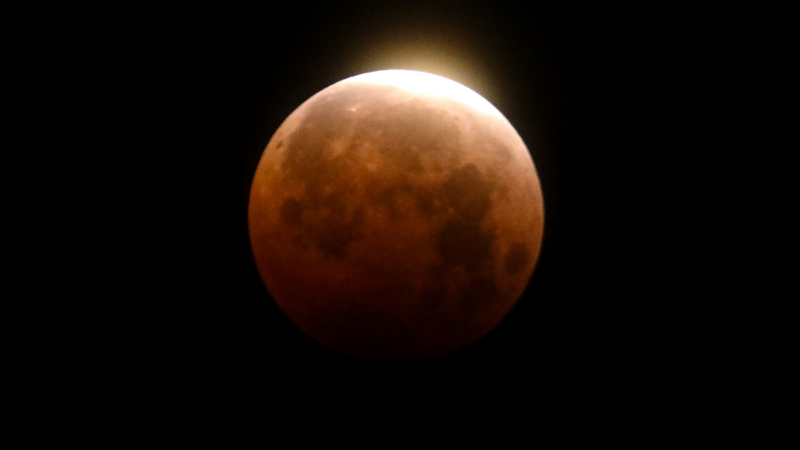What to know about this week’s ‘blood worm moon’ total lunar eclipse
Night owls across the U.S. and other parts of the world will be able to see the moon illuminated in a dusty red hue as it passes through the Earth’s shadow later this week during the total lunar eclipse.
Depending on your time zone, the celestial transit will occur Thursday evening or Friday morning and be visible in every U.S. state as well as other parts of the Western Hemisphere.
This total lunar eclipse — the first in three years — will feature a “blood worm moon,” so named for the reddish hue of its glow and the time of year it’s occurring.
Here’s what you need to know.
How to view the total lunar eclipse
A total lunar eclipse occurs when the sun, Earth and the moon align in roughly a straight line, with Earth in the middle. This is also known as syzygy.
The eclipse reaches totality as the full moon moves into the darkest part of Earth’s shadow, called the umbra.
People on the West Coast will see this week’s total lunar eclipse beginning at 11:26 p.m. on Thursday, while those on the East Coast will see it at 2:26 a.m. Friday morning. Totality will last for about 65 minutes. A partial eclipse will begin about an hour and 15 minutes before the total eclipse starts.

A dark environment will give you the best view of the eclipse, which can be seen with the naked eye. But a pair of binoculars or a telescope might make for a more impressive sight.
Because the Earth’s shadow will dim the radiance of the moon, you may also be able to see stars right next to the body’s edge, according to Sky & Telescope.
The magazine also noted that the top half of the moon may appear slightly brighter than the bottom half, since the moon won’t be centered in Earth’s umbra.
The origin of the phrase “worm moon”
A full moon in the month of March has historically been known as a worm moon, according to The Old Farmer’s Almanac.
That may be due to the emergence of earthworms around this time of year, as the weather warms up and spring nears.
But the publication offers another explanation for the name: in the 1760s, Captain Jonathan Carver documented that some Native American tribes used it to mark the appearance of beetle larvae from thawing tree bark.
Other names given to the March moon by various Native American tribes include the Eagle Moon, the Goose Moon, the Crow Comes Back Moon, the Sugar Moon, the Wind Strong Moon and the Sore Eyes Moon, the Almanac said.
Why the moon will take on a “blood” red color
Even though it will be fully in the Earth’s shadow, you’ll still be able to see the moon. That’s because it will be illuminated by light from the sun that passes through the edge of Earth’s atmosphere and bends toward the moon.
Long-wavelength red light traveling through that part of the sky will project a reddish hue onto the moon, giving it the sanguine moniker. Or as NASA puts it, the reddish-brown or reddish-orange color of the moon comes from “[t]he glow of all of the sunrises and sunsets on Earth.”
Exactly what shade of red the moon will assume may depend on how far into the umbra the moon travels and what’s present in Earth’s atmosphere — such as clouds or dust — at the time of the eclipse, Sky & Telescope said.
The term blood moon also refers to one of the full moons occurring near the beginning of fall, according to NASA.
Alabama Power seeks to delay rate hike for new gas plant amid outcry
The state’s largest utility has proposed delaying the rate increase from its purchase of a $622 million natural gas plant until 2028.
Former U.S. Sen. Doug Jones announces run for Alabama governor
Jones announced his campaign Monday afternoon, hours after filing campaign paperwork with the Secretary of State's Office. His gubernatorial bid could set up a rematch with U.S. Sen. Tommy Tuberville, the Republican who defeated Jones in 2020 and is now running for governor.
Scorching Saturdays: The rising heat threat inside football stadiums
Excessive heat and more frequent medical incidents in Southern college football stadiums could be a warning sign for universities across the country.
The Gulf States Newsroom is hiring an Audio Editor
The Gulf States Newsroom is hiring an Audio Editor to join our award-winning team covering important regional stories across Mississippi, Alabama and Louisiana.
Judge orders new Alabama Senate map after ruling found racial gerrymandering
U.S. District Judge Anna Manasco, appointed by President Donald Trump during his first term, issued the ruling Monday putting a new court-selected map in place for the 2026 and 2030 elections.
Construction on Meta’s largest data center brings 600% crash spike, chaos to rural Louisiana
An investigation from the Gulf States Newsroom found that trucks contracted to work at the Meta facility are causing delays and dangerous roads in Holly Ridge.









